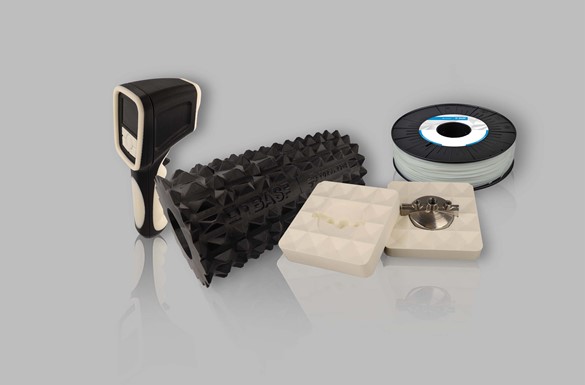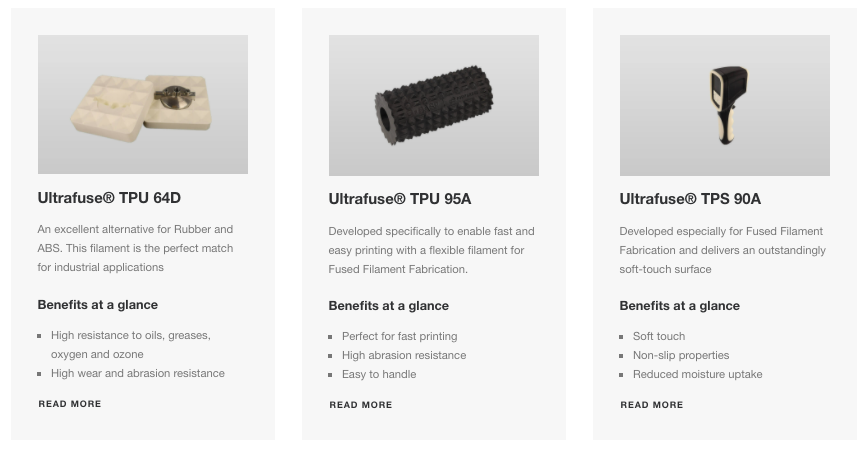BASF, one of the largest businesses in the 3D printing industry, is slowly rolling out its 3D printing materials with the possibility of overshadowing existing players in the space. Its latest line is a series of flexible filaments meant for “easy, rapid and cost- efficient production of 3D printed parts via Fused Filament Fabrication (FFF).”

The Forward AM Ultrafuse Flexible Filament Portfolio is made up of three materials: Ultrafuse TPU 64D, Ultrafuse TPU 95A and Ultrafuse TPS 90A. All three are meant to be soft, yet durable and offer mechanical strength and abrasion resistance, thus making them useful for industrial applications.
“Flexible materials surround us in our daily lives, in automotive manufacturing and production tools as well as in household appliances and consumer goods. In developing our Flexible Filament Portfolio we leveraged the decades of experience BASF has gathered in flexible materials such as Elastollan for traditional manufacturing. We are now transferring this expertise to AM to support our customers in realizing next-level industrial 3D printing applications with the very best flexible filaments on the market,” said Roger Sijlbing, Head of Sales and Marketing, Additive Extrusion Solutions at BASF 3D Printing Solutions GmbH.
Ultrafuse TPU 64D is the hardest of the elastomers in the series, with high rigidity and flexibility, making it ideal for impact-resistant parts. Ultrafuse TPU 95A is meant for quick and easy printing, while maintaining durability and flexibility, as well as abrasion resistance. For this reason, Forward AM, suggests its use for wear-and-tear applications. Finally, there’s Ultrafuse TPS 90A, which offers “unprecedented soft-touch surface haptics, giving printed parts a non-slip touch and feel.” It demonstrates low moisture uptake and “convincing layer adheision”, which BASF suggests makes it ideal for two component parts and appliance grips.

These new materials complement Forward AM’s existing flexible filaments, Ultrafuse TPU 85A and Ultrafuse TPC 45D. BASF believes that these newer filaments can be used for industrial applications, which has so far been difficult to achieve with existing materials on the market.
While firms such as NinjaTek have been working on flexible filaments for years, earning a great deal of consumer loyalty, it’s hard not to imagine a company like BASF taking over the market by sheer size, force, and finance alone. Meanwhile, the company has spun out a 3D printing service bureau dedicated to spare parts. I have little doubt that a reckoning is coming for others in the space, unless they get acquired by BASF or one of its competitors, like Mitsubishi Chemical.
Subscribe to Our Email Newsletter
Stay up-to-date on all the latest news from the 3D printing industry and receive information and offers from third party vendors.
You May Also Like
Model No. Deploys Titan Pellet 3D Printers for Sustainable Furniture Production
Over the years, many designers have tried to create 3D printed polymer furniture. Early pioneers like Janne Kyttanen, Materialise’s MGX, and Joris Laarman have led the way with 3D printed...
3D Printing News Unpeeled: Recycling PLA, More Efficient Atomizing
Filamentive hopes to recycle your PLA if you’re in the UK and order over £500 worth of filament. Their partner 3D Printing Waste (3DPW) will turn the PLA into injection...
Lighting the Way with Potato Starch: Sustainable Polish ECO Lamps Use 3D Printing
Lighting that meets the essence of nature: this is the reality brought to life by ECO Lamps, which introduces a fresh perspective to sustainable lighting design using potato starch. These...
3D Printing News Unpeeled: 3D Printed Construction Standard, Sand Wall & Self Heating Microfluidics
ISO/ASTM Standard 52939:2023 has been released and it sets standards for QA for 3D Printed polymer, composite and cement buildings. This is most welcome since 3D printed construction is a...
































